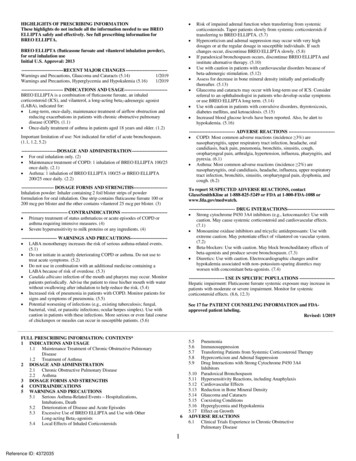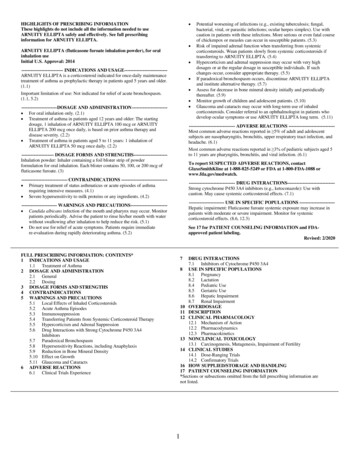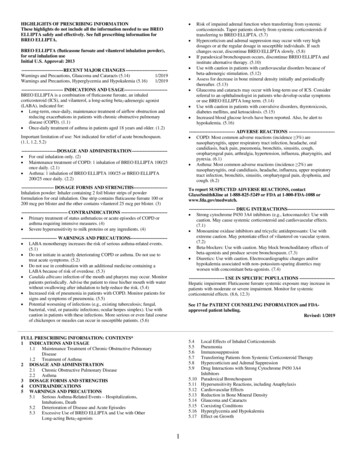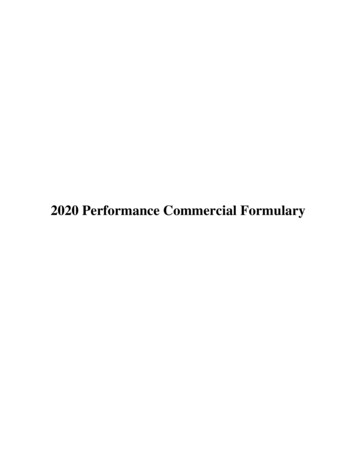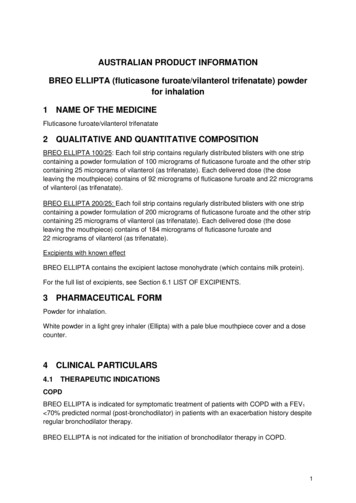
Transcription
AUSTRALIAN PRODUCT INFORMATIONBREO ELLIPTA (fluticasone furoate/vilanterol trifenatate) powderfor inhalation1 NAME OF THE MEDICINEFluticasone furoate/vilanterol trifenatate2 QUALITATIVE AND QUANTITATIVE COMPOSITIONBREO ELLIPTA 100/25: Each foil strip contains regularly distributed blisters with one stripcontaining a powder formulation of 100 micrograms of fluticasone furoate and the other stripcontaining 25 micrograms of vilanterol (as trifenatate). Each delivered dose (the doseleaving the mouthpiece) contains of 92 micrograms of fluticasone furoate and 22 microgramsof vilanterol (as trifenatate).BREO ELLIPTA 200/25: Each foil strip contains regularly distributed blisters with one stripcontaining a powder formulation of 200 micrograms of fluticasone furoate and the other stripcontaining 25 micrograms of vilanterol (as trifenatate). Each delivered dose (the doseleaving the mouthpiece) contains of 184 micrograms of fluticasone furoate and22 micrograms of vilanterol (as trifenatate).Excipients with known effectBREO ELLIPTA contains the excipient lactose monohydrate (which contains milk protein).For the full list of excipients, see Section 6.1 LIST OF EXCIPIENTS.3 PHARMACEUTICAL FORMPowder for inhalation.White powder in a light grey inhaler (Ellipta) with a pale blue mouthpiece cover and a dosecounter.4 CLINICAL PARTICULARS4.1THERAPEUTIC INDICATIONSCOPDBREO ELLIPTA is indicated for symptomatic treatment of patients with COPD with a FEV1 70% predicted normal (post-bronchodilator) in patients with an exacerbation history despiteregular bronchodilator therapy.BREO ELLIPTA is not indicated for the initiation of bronchodilator therapy in COPD.1
AsthmaBREO ELLIPTA is indicated in the regular treatment of moderate to severe asthma inpatients who require a medium to high dose inhaled corticosteroid combined with a longacting beta2-agonist.Vilanterol, an active ingredient in BREO ELLIPTA, is a long-acting beta2-agonist (LABA). Aclass effect of all LABAs can be an increased risk of asthma death (see Section 4.4SPECIAL WARNINGS AND PRECAUTIONS FOR USE).4.2DOSE AND METHOD OF ADMINISTRATIONDoseAsthmaPatients should be made aware that BREO ELLIPTA must be used regularly, even whenasymptomatic.If symptoms arise in the period between doses, an inhaled, short-acting beta2-agonist shouldbe taken for immediate relief.Patients should be regularly reassessed by a healthcare professional so that the strength ofBREO ELLIPTA they are receiving remains optimal and is only changed on medical advice.To minimise adverse reactions, inhaled corticosteroids should be used at the lowest dosethat maintains symptom control.Adults and adolescents aged 12 years and overThe recommended dose of BREO ELLIPTA is:One inhalation of BREO ELLIPTA 100/25 micrograms once dailyorOne inhalation of BREO ELLIPTA 200/25 micrograms once dailyA starting dose of BREO ELLIPTA 100/25 micrograms should be considered for patientswho require a mid-dose of inhaled corticosteroid in combination with a long acting beta2agonist.BREO ELLIPTA 200/25 micrograms should be considered for patients who require a higherdose of inhaled corticosteroid in combination with a long acting beta2-agonist.If patients are inadequately controlled on BREO ELLIPTA 100/25 micrograms, considerincreasing the dose to 200/25 micrograms, which may provide additional improvement inasthma control.2
Table 1. Recommended Doses of BREO ELLIPTA for asthma patients on existingtherapiesExisting therapyRecommended DoseFor patients uncontrolled on FP 100 micrograms to FP250 micrograms twice daily or equivalent (200-400 microgramstwice daily of budesonide)For patients uncontrolled on low doses of ICS/LABAcombinations (FP/salmeterol 100/50 micrograms twice daily orBudesonide/eformoterol 200/6 micrograms one or twoactuations twice daily)BREO ELLIPTA100/25 microgramsonce dailyFor patients controlled on mid doses of ICS/LABA(FP/salmeterol 250/50 micrograms twice daily orbudesonide/eformoterol 200/6 micrograms two actuations twicedaily)For patients uncontrolled on FP 500 micrograms twice daily orequivalent (600-800 micrograms twice daily of budesonide)For patients uncontrolled on mid doses of ICS/LABAcombinations (FP/salmeterol 250/50 micrograms twice daily orbudesonide/eformoterol 200/6 micrograms two actuations twicedaily)BREO ELLIPTA200/25 microgramsonce dailyFor patients controlled on high dose ICS/LABA combinations(FP/salmeterol 500/50 micrograms twice daily orbudesonide/eformoterol 400/12 micrograms two actuationstwice daily)Prescribers should be aware that 100 micrograms of fluticasone furoate is a medium dose ofinhaled corticosteroid and 200 micrograms of fluticasone furoate is a high dose of inhaledcorticosteroid. In patients with asthma, 100 micrograms of fluticasone furoate taken oncedaily produces similar effects to fluticasone propionate 250 micrograms taken twice daily and200 micrograms of fluticasone furoate taken once daily produces similar effects tofluticasone propionate 500 micrograms taken twice daily.To minimise adverse reactions, inhaled corticosteroids should be used at the lowest dosethat maintains symptom control. Patients should be assessed at regular intervals. In patientswhose asthma is well controlled and stable the BREO ELLIPTA dose may carefully be downtitrated to the lowest strength of BREO ELLIPTA.The next step should consider the cessation of BREO ELLIPTA and transfer to anappropriate inhaled corticosteroid containing regimen. When deemed clinically appropriatethe inhaled corticosteroid dose should be further adjusted to the lowest dose at whicheffective control of asthma is maintained.3
Additional recommendations for adolescents aged 12 years and olderDown-titration to the lowest inhaled corticosteroid dose is especially important in adolescentswho may be more susceptible to systemic corticosteroid effects (see Section 4.4 SPECIALWARNINGS AND PRECAUTIONS FOR USE). When down-titrating to another product,consideration should be given to maintaining a once-daily regimen to facilitate compliance.Children aged less than 12 yearsBREO ELLIPTA should not be used in children younger than 12 years of age.COPDAdultsThe recommended dose of BREO ELLIPTA is:One inhalation of BREO ELLIPTA 100/25 micrograms once daily.BREO ELLIPTA 200/25 micrograms is not indicated for patients with COPD. There is apotential increased risk of pneumonia and corticosteroid-related adverse reactions with the200/25 microgram dose (see Section 4.4 SPECIAL WARNINGS AND PRECAUTIONS FORUSE and Section 4.8 ADVERSE EFFECTS (UNDESIRABLE EFFECTS)).Asthma and COPDElderlyDue to limited data in patients with asthma aged 75 years and older, BREO ELLIPTA 200/25is not recommended.Renal impairmentNo dose adjustment is required for patients with renal impairment (see Section 5.2PHARMACOKINETIC PROPERTIES, Special Patient Populations).Hepatic ImpairmentA clinical pharmacology study in subjects with mild, moderate and severe hepaticimpairment showed up to 3-fold increase in systemic exposure to fluticasone furoate (AUC)(see Section 5.2 PHARMACOKINETIC PROPERTIES, Special Patient Populations).Caution should be exercised when dosing patients with hepatic impairment who may bemore at risk of systemic adverse reactions associated with corticosteroids.For patients with moderate or severe hepatic impairment the maximum dose is100/25 micrograms (see Section 5.2 PHARMACOKINETIC PROPERTIES).Method of administrationBREO ELLIPTA is for inhalation only.BREO ELLIPTA should be administered once daily either morning or evening but at thesame time every day.4
After inhalation, the patient should rinse their mouth with water without swallowing.4.3CONTRAINDICATIONSBREO ELLIPTA is contraindicated in patients with severe milk-protein allergy or who havedemonstrated hypersensitivity to either fluticasone furoate, vilanterol or any of the excipients.4.4SPECIAL WARNINGS AND PRECAUTIONS FOR USEPrecautions for useVilanterol, an active ingredient in BREO ELLIPTA, is a long-acting beta2-agonist (LABA).Limited post-marketing data are available for vilanterol; however, post-marketing data forother LABAs show that LABAs can be associated with an increased risk of asthma death.This is considered a class effect of all LABAs.Fluticasone furoate 100 micrograms is a medium dose of inhaled corticosteroid andfluticasone furoate 200 micrograms is a high dose of inhaled corticosteroid. Medium to highdoses of inhaled corticosteroids may cause systemic effects. These include growthretardation in adolescents (see below under Section 4.4 SPECIAL WARNINGS ANDPRECAUTIONS FOR USE, Systemic corticosteroid effects).BREO ELLIPTA should only be used for patients not adequately controlled on a long-term,asthma control medication, such as an inhaled corticosteroid. Patients should be assessedat regular intervals. The dose should be titrated to the lowest dose at which effective controlof symptoms is maintained. In patients whose asthma is well controlled and stable with thelowest strength of BREO ELLIPTA, the next step should consider cessation of BREOELLIPTA and transfer to maintenance therapy with an inhaled corticosteroid alone.BREO ELLIPTA should not be used more often than recommended, at higher doses thanrecommended, or in conjunction with other medicines containing LABA, as an overdose mayresult. Clinically significant cardiovascular effects and fatalities have been reported inassociation with excessive use of inhaled sympathomimetic drugs. Patients using BREOELLIPTA should not use another medicine containing a LABA (e.g., salmeterol, eformoterol,indacaterol) for any reason.BREO ELLIPTA 200/25 micrograms is not recommended for patients with COPD (seeSection 4.2 DOSE AND METHOD OF ADMINISTRATION).Deterioration of diseaseBREO ELLIPTA should not be used to treat acute asthma symptoms or an acuteexacerbation in COPD, for which a short-acting bronchodilator is required. Increasing use ofshort-acting bronchodilators to relieve symptoms indicates deterioration of control andpatients should be reviewed by a physician.Patients with asthma or COPD should have a personal action plan designed in associationwith their general practitioner. Patients should not stop therapy with BREO ELLIPTA, inasthma or COPD, without physician supervision since symptoms may recur afterdiscontinuation.Serious and potentially life-threatening, asthma-related adverse events and exacerbationsmay occur during treatment with BREO ELLIPTA. Patients should be asked to continuetreatment but to seek medical advice if asthma symptoms remain uncontrolled or worsenafter initiation of fluticasone furoate/vilanterol.5
Paradoxical bronchospasmAs with other inhalation therapy, paradoxical bronchospasm may occur with an immediateincrease in wheezing after dosing. This should be treated immediately with a short-actinginhaled bronchodilator. BREO ELLIPTA should be discontinued immediately, the patientassessed and alternative therapy instituted if necessary.Cardiovascular effects (see Section 4.8 ADVERSE EFFECTS (UNDESIRABLEEFFECTS))Cardiovascular effects, such as cardiac arrhythmias e.g. supraventricular tachycardia andextrasystoles may be seen with sympathomimetic drugs, including fluticasonefuroate/vilanterol. In addition, beta2-agonists have been reported to produceelectrocardiographic changes, such as flattening of the T wave, prolongation of the QTcinterval, and ST segment depression, although the clinical significance of these findings isunknown. Therefore, BREO ELLIPTA should be used with caution in patients with severecardiovascular disease.Use in hepatic impairmentFor patients with moderate to severe hepatic impairment, the 100/25 micrograms doseshould be used and patients should be monitored for systemic corticosteroid-related adversereactions (see Section 4.2 DOSE AND METHOD OF ADMINISTRATION and Section 5.2PHARMACOKINETIC PROPERTIES).Systemic corticosteroid effectsSystemic effects may occur with any inhaled corticosteroid, particularly at high dosesprescribed for long periods. These effects are much less likely to occur than with oralcorticosteroids. Possible systemic effects include Cushing’s syndrome, Cushingoid features,adrenal suppression, decrease in bone mineral density, growth retardation in children andadolescents, and more rarely, a range of psychological or behavioural effects includingpsychomotor hyperactivity, sleep disorders, anxiety, depression or aggression (particularly inchildren).Ocular effects may be reported with systemic and topical corticosteroid use. If a patientpresents with a change in vision, the patient should be considered for referral to anophthalmologist for evaluation of possible causes which may include cataract, glaucoma orrare diseases such as central serous chorioretinopathy (CSCR).Inhaled corticosteroids should be used with caution in patients with active or quiescenttuberculosis infections of the respiratory tract; systemic fungal, bacterial, viral, or parasiticinfections; or ocular herpes simplex.HyperglycaemiaThere have been reports of increases in blood glucose levels with fluticasonefuroate/vilanterol. This should be considered in patients with a history of, or with risk factorsfor, diabetes mellitus (see Section 4.8 ADVERSE EFFECTS (UNDESIRABLE EFFECTS)).PneumoniaAn increase in pneumonia has been observed in patients with COPD receiving fluticasonefuroate/vilanterol. There was also an increased incidence of pneumonias resulting inhospitalisation. In some incidences these pneumonia events were fatal (see Section 5.1PHARMACODYNAMIC PROPERTIES, Clinical trials and Section 4.8 ADVERSE EFFECTS6
(UNDESIRABLE EFFECTS)). Physicians should remain vigilant for the possibledevelopment of pneumonia in patients with COPD as the clinical features of such infectionsoverlap with the symptoms of COPD exacerbations. Risk factors for pneumonia in patientswith COPD receiving fluticasone furoate/vilanterol include current smokers, patients with ahistory of prior pneumonia, patients with a body mass index 25 kg/m2 and patients with a(forced expiratory volume) FEV1 50% predicted. These factors should be considered whenBREO ELLIPTA is prescribed and treatment should be re-evaluated if pneumonia occurs.BREO ELLIPTA 200/25 micrograms is not indicated for patients with COPD. There is apotential increased risk of pneumonia and systemic corticosteroid-related adverse reactionswith fluticasone furoate/vilanterol 200/25 micrograms (see Section 4.8 ADVERSE EFFECTS(UNDESIRABLE EFFECTS)).The incidence of pneumonia in patients with asthma taking fluticasone furoate/vilanterol200/25 micrograms was numerically higher compared with those receiving fluticasonefuroate/vilanterol 100/25 or placebo (see Section 4.8 ADVERSE EFFECTS (UNDESIRABLEEFFECTS)). No risk factors were identified.Sensitivity to sympathomimetic aminesBREO ELLIPTA, like all medicines containing sympathomimetic amines, should be used withcaution in patients with convulsive disorders or hyperthyroidism and in those who areunusually responsive to sympathomimetic amines.Hypokalaemia and HyperglycaemiaBeta-adrenergic agonist medicines may produce significant hypokalaemia in some patients,possibly through intracellular shunting, which has the potential to produce adversecardiovascular effects. The decrease in serum potassium is usually transient, not requiringsupplementation. Beta-agonist medications may produce transient hyperglycaemia in somepatients. In clinical trials evaluating fluticasone furoate/vilanterol in subjects with asthma orCOPD, there was no evidence of a treatment effect on serum glucose or potassium.Use in the elderlyDue to limited data in patients with asthma aged 75 years and older, BREO ELLIPTA 200/25is not recommended.Paediatric useBREO ELLIPTA should not be used in children (i.e. patients younger than 12 years of age).Effects on laboratory testsInteractions with laboratory tests have not been established.4.5INTERACTIONS WITH OTHER MEDICINES AND OTHER FORMS OFINTERACTIONSClinically significant drug interactions mediated by fluticasone furoate or vilanterol at clinicaldoses are considered unlikely due to the low plasma concentrations achieved after inhaleddosing.7
Interaction with beta-blockersBeta-adrenergic blockers may weaken or antagonise the effect of beta2-adrenergic agonists.Concurrent use of both non-selective and selective beta-blockers should be avoided unlessthere are compelling reasons for their use.Interaction with CYP3A4 inhibitorsFluticasone furoate and vilanterol are both rapidly cleared by extensive first pass metabolismmediated by the liver enzyme CYP3A4.Care is advised when co-administering with strong CYP 3A4 inhibitors (e.g. ketoconazole,ritonavir) as there will be increased systemic exposure to both fluticasone furoate andvilanterol, which could lead to an increase in the potential for adverse reactions (seeSection 5.2 PHARMACOKINETIC PROPERTIES).Interaction with P-glycoprotein inhibitorsFluticasone furoate and vilanterol are both substrates of P-gp. A clinical pharmacology studyin healthy subjects with co-administered vilanterol and the potent P-gp and moderateCYP3A4 inhibitor verapamil did not show any significant effect on the pharmacokinetics ofvilanterol. Clinical pharmacology studies with a specific P-gp inhibitor and fluticasone furoatehave not been conducted.Interaction with sympathomimetic medicinal productsConcomitant administration of other sympathomimetic agents (alone or as part ofcombination therapy) may potentiate the undesirable effects of BREO ELLIPTA. BREOELLIPTA should not be used in conjunction with other long-acting beta2-adrenergic agonistsor medicinal products containing long-acting beta2-adrenergic agonists.Interaction with monoamine oxidase inhibitors and tricyclic antidepressantsVilanterol, like other beta2-agonists, should be administered with extreme caution to patientsbeing treated with monoamine oxidase inhibitors, tricyclic antidepressants, or drugs knownto prolong the QTc interval because the effect of adrenergic agonists on the cardiovascularsystem may be potentiated by these agents. Drugs that are known to prolong the QTcinterval have an increased risk of ventricular arrhythmias.4.6FERTILITY, PREGNANCY AND LACTATIONEffects on fertilityThere are no fertility data in humans. Studies in rats showed no effect of vilanterol orfluticasone furoate on male or female fertility.Use in pregnancy(Pregnancy Category B3)There are no adequate and well-controlled trials with fluticasone furoate/vilanterol inpregnant women. Corticosteroids and beta2-agonists have been shown to be teratogenic inlaboratory animals when administered systematically at relatively low dosage levels.Maternal and fetal toxicity (likely due to the fluticasone furoate component) were observed inrat embryofetal development study with the fluticasone/vilanterol combination at fluticasone8
furoate doses of 29.5 and 82 µg/kg/day, respectively (equivalent to 3 and 9 times,respectively, the clinical exposure based on AUC).In rabbits, there was evidence of maternal toxicity and embryotoxicity following inhalationexposure to vilanterol triphenylacetate at 591 and 62.7 µg/kg/day, respectively (equivalent to150 and 14 times the clinical exposure based on AUC). A non-dose related increase inmalformations, including the rare open eyelid, was also observed. In a separate study withsubcutaneous exposure, increased incidence of open eye and increase in skeletal variations(indicative of developmental delay) occurred at 300 µg/kg/day (equivalent to 1000 times theclinical exposure based on AUC) with a NOAEL of 30 µg/kg/day (equivalent to 84 times theclinical exposure based on AUC).Administration of BREO ELLIPTA to pregnant women should only be considered if theexpected benefit to the mother is greater than any possible risk to the foetus.Use in lactationThere is limited information on the excretion of fluticasone furoate or vilanterol or theirmetabolites in human milk. However, other corticosteroids and beta2-agonists are detectedin human milk. A risk to breastfed newborns/infants cannot be excluded.A decision must be made whether to discontinue breast-feeding or to discontinue BREOELLIPTA therapy taking into account the benefit of breast-feeding for the child and thebenefit of therapy for the woman.4.7EFFECTS ON ABILITY TO DRIVE AND USE MACHINESThere have been no studies to investigate the effect of fluticasone furoate/vilanterol ondriving performance or the ability to operate machinery. A detrimental effect on suchactivities would not be anticipated from the pharmacology of fluticasone furoate or vilanterol.4.8ADVERSE EFFECTS (UNDESIRABLE EFFECTS)Clinical trial dataThe most frequent adverse events, based on studies including a comparator, are presentedin Table 2 and Table 3 for asthma and COPD, respectively.Table 2. Adverse Events With 3% Incidence With Fluticasone Furoate/Vilanterol inAsthma (Integrated Asthma Clinical Studies)Adverse Event(Preferred Term)PlaceboN 680FF/VI100/25N 1467Any eal painCoughSinusitisBack painInfluenzaPharyngitis184 (27)44 (6)35 (5)10 (1)13 (2)7 (1)8 (1)5 ( 1)2 ( 1)1 ( 1)8 (1)857 (58)252 (17)202 (14)110 (7)67 (5)53 (4)64 (4)54 (4)51 (3)51 (3)37 (3)Number (%) of SubjectsFF/VI200/25FF 100FF 200N 455N 1544N 489247 (54)55 (12)45 (10)32 (7)16 (4)16 (4)14 (3)7 (2)17 (4)8 (2)8 (2)842 (55)216 (14)167 (11)109 (7)84 (5)68 (4)68 (4)45 (3)48 (3)40 (3)48 (3)181 (37)29 (6)38 (8)8 (2)7 (1)14 (3)10 (2)10 (2)7 (1)9 (2)4 ( 1)Placebo ICSN 218VI 25 ICSN 21684 (39)13 (6)16 (7)10 (5)08 (4)1 ( 1)3 (1)1 ( 1)3 (1)3 (1)78 (36)17 (8)9 (4)4 (2)07 (3)002 ( 1)1 ( 1)2 ( 1)9
Adverse Event(Preferred Term)PlaceboN 680FF/VI100/25N 1467Number (%) of SubjectsFF/VI200/25FF 100FF 200N 455N 1544N 489Placebo ICSN 218VI 25 ICSN 216Dysphonia4 ( 1)38 (3)13 (3)21 (1)8 (2)4 (2)0Rhinitis allergic5 ( 1)49 (3)5 (1)27 (2)1 ( 1)1 ( 1)4 (2)Abdominal pain upper3 ( 1)44 (3)12 (3)28 (2)2 ( 1)3 (1)2 ( 1)Pyrexia1 ( 1)33 (2)16 (4)22 (1)5 (1)1 ( 1)5 (2)Oral candidiasis024 (2)15 (3)17 (1)5 (1)00Extrasystoles05 ( 1)15 (3)0000Note: The integrated asthma data set is based on 11 Phase II and III studies and a total of 7,034 patients.1 URTI Upper respiratory tract infectionTable 3. Adverse Events With 3% Incidence With Fluticasone Furoate/Vilanterol inCOPD (Studies HZC112206/HZC112207)Preferred Term, n (%)PlaceboN 412FF/VI100/25N 410FF/VI200/25N 205VI25N 408FF100N 410FF200N 203Nasopharyngitis31 (8)35 (9)13 (6)41 (10)32 (8)20 (10)Headache20 (5)29 (7)15 (7)36 (9)30 (7)11 (5)URTI113 (3)29 (7)7 (3)20 (5)16 (4)5 (2)Oral/ Oropharyngeal candidiasis*9 (2)22 (5)9 (4)9 (2)13 (3)13 (6)Note: AEs reported by 3% or more of subjects in any treatment group and at a higher incidence ( 1%)than placebo1 URTI Upper respiratory tract infection*Includes terms oral candidiasis, oropharyngeal candidiasis, candidiasis, and oropharyngitis fungal.Data from large asthma and COPD clinical trials were used to determine the frequency ofadverse reactions associated with fluticasone furoate/vilanterol. In the asthma clinicaldevelopment program a total of 7,034 patients were included in an integrated assessment ofadverse reactions. In the COPD clinical development program a total of 6,237 subjects wereincluded in an integrated assessment of adverse reactions.With the exception of pneumonia and fractures, the safety profile was similar in patients withasthma and COPD. During clinical studies, pneumonia and fractures were more frequentlyobserved in patients with COPD.These adverse reactions are listed by system organ class and frequency. The followingconvention has been used for the classification of adverse reactions:10
Very common: 1/10Common: 1/100 to 1/10Uncommon: 1/1000 to 1/100Rare: 1/10000 to 1/1000Very rare: 1/10000Table 4. Adverse Reactions with BREO ELLIPTA listed by MedDRA system organclass and frequencySystem organ classAdverse reaction(s)FrequencyInfections andinfestationsPneumonia*CommonUpper respiratory tract infectionBronchitis, InfluenzaCandidiasis of mouth and throatNervous systemdisordersHeadacheVery commonCardiac disordersExtrasystolesUncommonRespiratory, thoracic &mediastinal disordersNasopharyngitisVery commonOropharyngeal pain,CommonSinusitis, Pharyngitis,Rhinitis, Cough, DysphoniaGastrointestinaldisordersAbdominal painCommonMusculoskeletal andconnective tissuedisordersArthralgia, Back painCommonGeneral disorders andadministration siteconditionsPyrexiaFractures**Common11
Description of selected adverse reactions*Pneumonia (see Section 4.4 SPECIAL WARNINGS AND PRECAUTIONS FOR USE)In two replicate 12-month studies in a total of 3,255 patients with COPD (mean postbronchodilator screening FEV1 45% of predicted, standard deviation (SD) 13%) who hadexperienced a COPD exacerbation in the previous year, there was a higher incidence ofpneumonia (6%-7%) reported in patients receiving the fluticasone furoate (at strengths of 50,100, and 200 micrograms)/vilanterol 25 micrograms combination than in those receivingvilanterol 25 micrograms alone (3%). Pneumonia which required hospitalisation occurred in3% of patients receiving fluticasone furoate/vilanterol (all strengths) and in 1% of patientsreceiving vilanterol. In these studies, nine fatal cases of pneumonia were reported. Of these,seven were reported during treatment with fluticasone furoate/vilanterol 200/25 micrograms,one during treatment with fluticasone furoate/vilanterol 100/25 micrograms, and one posttreatment with vilanterol monotherapy. Risk factors for pneumonia observed in these studiesincluded current smokers, patients with a history of prior pneumonia, patients with a bodymass index 25 kg/m2 and patients with an FEV1 50% predicted (see Section 4.4 SPECIALWARNINGS AND PRECAUTIONS FOR USE).In SUMMIT, a multi-centre, randomised study (HZC113782), 16,568 subjects (safetypopulation) received fluticasone furoate/vilanterol 100/25 micrograms, fluticasone furoate100 micrograms, vilanterol 25 micrograms or placebo for a mean of 1.7 years. Subjects hadmoderate COPD (mean post-bronchodilator screening FEV1 60% of predicted, SD 6%) anda history of, or an increased risk of, cardiovascular disease. The annualised event rate (per1000 treatment-years) of serious pneumonia was 22.4 for fluticasone furoate/vilanterol100/25, 25.1 for fluticasone furoate 100 micrograms, 16.4 for vilanterol 25 micrograms, and22.2 for placebo. The annualised event rate (per 1000 treatment-years) for adjudicated, ontreatment deaths due to pneumonia was 1.8 for fluticasone furoate/vilanterol 100/25, 1.5 forfluticasone furoate 100 micrograms, 0.9 for vilanterol 25 micrograms, and 1.4 for placebo.In an integrated analysis of 11 studies in asthma (7,034 patients), the incidence ofpneumonia (adjusted for exposure, due to low numbers and limited number of patients onplacebo) seen with fluticasone furoate/vilanterol 100/25 microgram strength(9.6/1000 patient years) was similar to placebo (8.0/1000 patient years). There was a higherincidence of pneumonia in the 200/25 microgram strength (18.4/1000 patient years)compared to the 100/25 microgram strength. Few of the pneumonia events led tohospitalisation with either strength, and there were no observed differences in the incidenceof serious events between the two treatment strengths.Cardiovascular events (see Section 4.4 SPECIAL WARNINGS AND PRECAUTIONS FORUSE)For the SUMMIT study (see description above), the annualised event rate (per1000 treatment-years) of serious cardiovascular events was 64.5 for fluticasonefuroate/vilanterol 100/25, 58.1 for fluticasone furoate 100 micrograms, 59.2 for vilanterol25 micrograms, and 63.2 for placebo. The annualised event rate (per 1000 treatment-years)for adjudicated cardiovascular deaths was 11.7 for fluticasone furoate/vilanterol 100/25, 11.6for fluticasone furoate 100 micrograms, 12.9 for vilanterol 25 micrograms, and 13.0 forplacebo.12
**FracturesIn two replicate 12-month studies in a total of 3,255 patients with COPD the incidence ofbone fractures overall was low in all treatment groups, with a higher incidence in allfluticasone furoate/vilanterol groups (2%) compared with the vilanterol 25 micrograms group( 1%). Although there were more fractures in the fluticasone furoate/vilanterol groupscompared with the vilanterol 25 micrograms group, fractures typically associated withcorticosteroid use (e.g., spinal compression/thoracolumbar vertebral fractures, hip andacetabular fractures) occurred in 1% of the fluticasone furoate/vilanterol and vilanteroltreatment arms.In an integrated analysis of 11 studies in asthma (7,034 patients), the incidence of fractureswas 1%, and usually associated with trauma.Post-marketing dataThere are limited post-marketing data available. Because of the limited long-term safety data(beyond one year) for BREO ELLIPTA, assumptions about long-term safety for thiscombination product have been based on data from pharmaceuticals in the same class.Table 5. PostmarketingdataSystem organclassAdverse reaction(s)FrequencyImmune systemdisordersHypersensitivity reactions includinganaphylaxis, angioedema, rash, andurticaria.RareMetabolism andnutrition disordersHyperglycaemiaUncommonPsychiatric disordersAnxietyRareNervous systemdisordersTremorRareCardiac y, thoracicand mediastinaldisordersParadoxical bronchospasmRareMusculoskeletal andconnective tissuedisordersMuscle spasmsCommon13
Reporting suspected adverse effectsReporting suspected adverse reactions after registration of the medicinal product isimportant. It allows continued monitoring of the benefit-risk balance of the medicinal product.Healthcare professionals are asked to report any suspected adverse reactions ptoms and signsThere are no data available from clinical trials on overdose with BREO ELLIPTA.An overdose of BREO ELLIPTA may produce signs and symptoms due to the individualcomponents’ actions, including
4.1 THERAPEUTIC INDICATIONS COPD BREO ELLIPTA is indicated for symptomatic treatment of patients with COPD with a FEV 1 70% predicted normal (post-bronchodilator) in patients with an exacerbation history despite regular bronchodilator therapy. BREO ELLIPTA is not indicated for the initiation of bronchodilator therapy in COPD.

